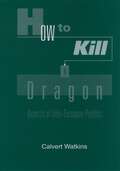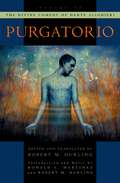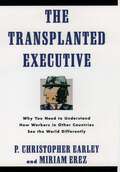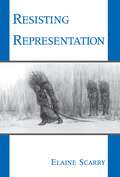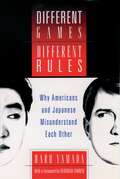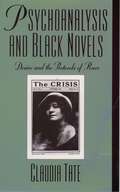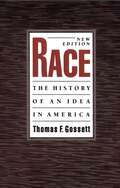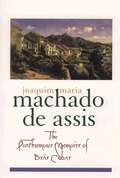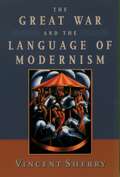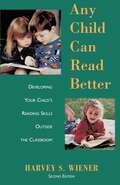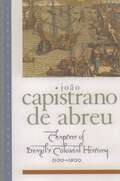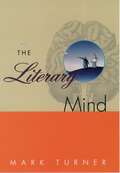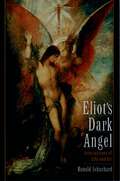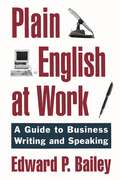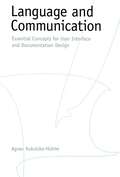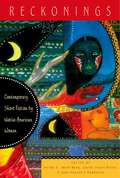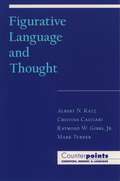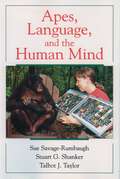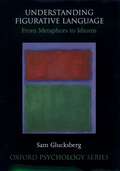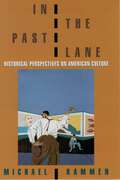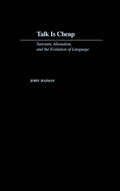- Table View
- List View
How to Kill a Dragon: Aspects of Indo-European Poetics
by Calvert WatkinsIn How to Kill a Dragon Calvert Watkins follows the continuum of poetic formulae in Indo-European languages, from Old Hittite to medieval Irish. He uses the comparative method to reconstruct traditional poetic formulae of considerable complexity that stretch as far back as the original common language. Thus, Watkins reveals the antiquity and tenacity of the Indo-European poetic tradition. Watkins begins this study with an introduction to the field of comparative Indo-European poetics; he explores the Saussurian notions of synchrony and diachrony, and locates the various Indo-European traditions and ideologies of the spoken word. Further, his overview presents case studies on the forms of verbal art, with selected texts drawn from Indic, Iranian, Greek, Latin, Hittite, Armenian, Celtic, and Germanic languages. In the remainder of the book, Watkins examines in detail the structure of the dragon/serpent-slaying myths, which recur in various guises throughout the Indo-European poetic tradition. He finds the "signature" formula for the myth--the divine hero who slays the serpent or overcomes adversaries--occurs in the same linguistic form in a wide range of sources and over millennia, including Old and Middle Iranian holy books, Greek epic, Celtic and Germanic sagas, down to Armenian oral folk epic of the last century. Watkins argues that this formula is the vehicle for the central theme of a proto-text, and a central part of the symbolic culture of speakers of the Proto-Indo-European language: the relation of humans to their universe, the values and expectations of their society. Therefore, he further argues, poetry was a social necessity for Indo- European society, where the poet could confer on patrons what they and their culture valued above all else: "imperishable fame."
The Divine Comedy of Dante Alighieri: Volume 2: Purgatorio (First Avenue Classics)
by Robert M. DurlingIn the early 1300s, Dante Alighieri set out to write the three volumes which make the up The Divine Comedy. Purgatorio is the second volume in this set and opens with Dante the poet picturing Dante the pilgrim coming out of the pit of hell. Similar to the Inferno (34 cantos), this volume is divided into 33 cantos, written in tercets (groups of 3 lines). The English prose is arranged in tercets to facilitate easy correspondence to the verse form of the Italian on the facing page, enabling the reader to follow both languages line by line. In an effort to capture the peculiarities of Dante's original language, this translation strives toward the literal and sheds new light on the shape of the poem. Again the text of Purgatorio follows Petrocchi's La Commedia secondo l'antica vulgata, but the editor has departed from Petrocchi's readings in a number of cases, somewhat larger than in the previous Inferno, not without consideration of recent critical readings of the Comedy by scholars such as Lanza (1995, 1997) and Sanguineti (2001). As before, Petrocchi's punctuation has been lightened and American norms have been followed. However, without any pretensions to being "critical", the text presented here is electic and being not persuaded of the exclusive authority of any manuscript, the editor has felt free to adopt readings from various branches of the stemma. One major addition to this second volume is in the notes, where is found the Intercantica - a section for each canto that discusses its relation to the Inferno and which will make it easier for the reader to relate the different parts of the Comedy as a whole.
The Transplanted Executive: Why You Need To Understand How Workers In Other Countries See The World Differently
by P. Christopher Earley Miriam ErezResisting Representation
by Elaine ScarryRenowned scholar Elaine Scarry's book, The Body in Pain, has been called by Susan Sontag "extraordinary...large-spirited, heroically truthful." The Los Angeles Times called it "brilliant, ambitious, and controversial." Now Oxford has collected some of Scarry's most provocative writing. This collection of essays deals with the complicated problems of representation in diverse literary and cultural genres--from her beloved sixth-century philosopher Boethius, through the nineteenth-century novel, to twentieth-century advertising. qWe often assume that all areas of experience are equally available for representation. On the contrary, these essays present discussions of experiences and concepts that challenge, defeat, or block representation. Physical pain, physical labor, the hidden reflexes of cognition and its judgments about the coherence or incoherence of the world are all phenomena that test the resources of language. Using primarily literary sources (works by Hardy, Beckett, Boethius, Thackeray, and others), Scarry also draws on painting, medical advertising, and philosophic dialogue to probe the limitations of expression and representation. Resisting Representation celebrates language. It looks at the problematic areas of expression not at the moment when representation is resisted, but at the moment when that resistance is at last overcome, thus suggesting a domain of plenitude and inclusion.
Different Games, Different Rules: Why Americans and Japanese Misunderstand Each Other
by Haru YamadaJapan and the United States are in closer contact politically and economically than ever before, yet in many ways our nations are as far from mutual understanding as ever. Misconceptions and miscommunications between East and West continue to plague this important relationship, frustrating the best efforts of both cultures to work together. Stereotypes abound: Americans see Japanese as evasive and inscrutable, while Japanese see Americans as pushy and selfish. What causes these persistent misunderstandings, and what can be done to avoid them? Fluent in both languages and at home in both cultures, Haru Yamada brings an insiders perspective and a linguists training to this difficult question, illuminating the many reasons why Americans and Japanese misunderstand one another. Social organization, she explains, shapes the way we talk. Because American and Japanese cultures value different kinds of social relationships, they play different language games with different sets of rules. In America, for instance, Aesop's fable about the grasshopper and the ants ends with the ants scorning the foolhardy grasshopper. In Japan, however, the story has a very different ending: the ants invite the grasshopper in to share their winter meal, as they appreciate how his singing spurred them on during their summer labors. In the difference between these two endings, argues Yamada, lies an important lesson: Americans, because of their unique political history, value independence and individuality, while Japanese value mutual dependency and interconnectedness. The language of both cultures is designed to display and reinforce these values so that words, phrases and expressions in one language can have completely different connotations in another, leading to all manner of misunderstanding. Yamada provides numerous examples. In Japan, for instance, silence is valued and halting speech is considered more honest and thoughtful than fluid speech, while in America forthright, polished speech is valued. Likewise, the Japanese use word order to express emphasis, while Americans use vocal stress: a listener unaware of this difference may easily misunderstand the import of a sentence. In a lucid and insightful discussion, Yamada outlines the basic differences between Japanese and American English and analyzes a number of real-life business and social interactions in which these differences led to miscommunication. By understanding how and why each culture speaks in the way that it does, Yamada shows, we can learn to avoid frustrating and damaging failures of communication. Different Games, Different Rules is essential reading for anyone who travels to or communicates regularly with Japan, whether they are scientists, scholars, tourists, or business executives. But as Deborah Tannen notes in her Foreword to the book, even those who will never travel to Japan, do business with a Japanese company, or talk to a person from that part of the world, will find the insights of this book illuminating and helpful, because the greatest benefit that comes of understanding another culture is a better and deeper understanding of one's own.
Psychoanalysis And Black Novels: Desire And The Protocols Of Race
by Claudia TateAlthough psychoanalytic theory is one of the most potent and influential tools in contemporary literary criticism, to date it has had very little impact on the study of African American literature. Critical methods from the disciplines of history, sociology, and cultural studies have dominated work in the field. Now, in this exciting new book by the author ofDomestic Allegories: The Black Heroine's Text at the Turn of the Century, Claudia Tate demonstrates that psychoanalytic paradigms can produce rich and compelling readings of African American textuality. With clear and accessible summaries of key concepts in Freud, Lacan, and Klein, as well as deft reference to the work of contemporary psychoanalytic critics of literature, Tate explores African- American desire, alienation, and subjectivity in neglected novels by Emma Kelley, W.E.B. Du Bois, Richard Wright, Zora Neale Hurston, and Nella Larsen. Her pioneering approach highlights African American textual realms within and beyond those inscribing racial oppression and modes of black resistance. A superb introduction to psychoanalytic theory and its applications for African American literature and culture, this book creates a sophisticated critical model of black subjectivity and desire for use in the study of African American texts.
Psychoanalysis and Black Novels: Desire and the Protocols of Race (Race and American Culture)
by Claudia TateAlthough psychoanalytic theory is one of the most potent and influential tools in contemporary literary criticism, to date it has had very little impact on the study of African American literature. Critical methods from the disciplines of history, sociology, and cultural studies have dominated work in the field. Now, in this exciting new book by the author of Domestic Allegories: The Black Heroine's Text at the Turn of the Century, Claudia Tate demonstrates that psychoanalytic paradigms can produce rich and compelling readings of African American textuality. With clear and accessible summaries of key concepts in Freud, Lacan, and Klein, as well as deft reference to the work of contemporary psychoanalytic critics of literature, Tate explores African- American desire, alienation, and subjectivity in neglected novels by Emma Kelley, W.E.B. Du Bois, Richard Wright, Zora Neale Hurston, and Nella Larsen. Her pioneering approach highlights African American textual realms within and beyond those inscribing racial oppression and modes of black resistance. A superb introduction to psychoanalytic theory and its applications for African American literature and culture, this book creates a sophisticated critical model of black subjectivity and desire for use in the study of African American texts.
Race: The History of an Idea in America (Race and American Culture)
by Thomas F. GossettWhen Thomas Gossett's Race: The History of an Idea in America appeared in 1963, it explored the impact of race theory on American letters in a way that anticipated the investigation of race and culture being conducted today. Bold, rigorous, and broad in scope, Gossett's book quickly established itself as a critical resource to younger scholars seeking a candid, theoretically sophisticated treatment of race in American cultural history. Here, reprinted without change, is Gossett's classic study, making available to a new generation of scholars a lucid, accessibly written volume that ranges from colonial race theory and its European antecedents, through eighteenth- and nineteenth- century race pseudoscience, to the racialist dimension of American thought and literature emerging against backgrounds such as Anglo- Saxonism, westward expansion, Social Darwinism, xenophobia, World War I, and modern racial theory. Featuring a new afterword by the author, an introduction by series editors Shelley Fisher Fishkin and Arnold Rampersad, and a bibliographic essay by Maghan Keita, this indispensable book, whose first edition helped change the way scholars discussed race, will richly reward scholars of American Studies, American Literature, and African-American Studies.
The Posthumous Memoirs of Brás Cubas (Library of Latin America)
by Joaquim Maria Machado de Assis"Be aware that frankness is the prime virtue of a dead man," writes the narrator of The Posthumous Memoirs of Brás Cubas. But while he may be dead, he is surely one of the liveliest characters in fiction, a product of one of the most remarkable imaginations in all of literature, Brazil's greatest novelist of the nineteenth century, Joaquim Maria Machado de Assis. By turns flippant and profound, The Posthumous Memoirs of Brás Cubas is the story of an unheroic man with half-hearted political ambitions, a harebrained idea for curing the world of melancholy, and a thousand quixotic theories unleashed from beyond the grave. It is a novel that has influenced generations of Latin American writers but remains refreshingly and unforgettably unlike anything written before or after it. Newly translated by Gregory Rabassa and superbly edited by Enylton de Sá Rego and Gilberto Pinheiro Passos, this Library of Latin America edition brings to English-speaking readers a literary delight of the highest order.
The Great War and the Language of Modernism
by Vincent SherryWith the expressions "Lost Generation" and "The Men of 1914," the major authors of modernism designated the overwhelming effect the First World War exerted on their era. Literary critics have long employed the same phrases in an attempt to place a radically experimental, specifically modernist writing in its formative, historical setting. What real basis did that Great War provide for the verbal inventiveness of modernist poetry and fiction? Does the literature we bring under this heading respond directly to that provocation, and, if so, what historical memories or revelations can be heard to stir in these words? Vincent Sherry reopens these long unanswered questions by focusing attention on the public culture of the English war. He reads the discourses through which the Liberal party constructed its cause, its Great Campaign. A breakdown in the established language of liberal modernity--the idioms of public reason and civic rationality--marked the sizable crisis this event represents in the mainstream traditions of post-Reformation Europe. If modernist writing characteristically attempts to challenge the standard values of Enlightenment rationalism, this study recovers the historical cultural setting of its most substantial and daring opportunity. And this moment was the occasion for great artistic innovations in the work of Virginia Woolf, T.S. Eliot, and Ezra Pound. Combining the records of political journalism and popular intellectual culture with abundant visual illustration, Vincent Sherry provides the framework for new interpretations of the major texts of Woolf, Eliot, and Pound. With its relocation of the verbal imagination of modernism in the context of the English war, The Great War and the Language of Modernism restores the historical content and depth of this literature, revealing its most daunting import.
Any Child Can Read Better: Developing Your Child's Reading Skills Outside the Classroom
by Harvey S. WienerReading, however fundamental the task may seem to everyday life, is a complex process that takes years to master. Yet, learning to read in the early stages is not an overwhelming problem for most children, especially when their classroom learning is coupled with a nurturing home environment in which reading is cherished, and pencil and paper are always available and fun to use. In fact, studies have shown that children score higher in reading if their parents support and encourage them at home. Unfortunately, though many parents want to involve themselves actively in their children's education, very few know just what to do. Now Dr. Harvey S. Wiener, author of the classic Any Child Can Write, provides an indispensable guide for parents who want to help their children enter the magic realm of words. In Any Child Can Read Better, Second Edition, Dr. Wiener offers practical advice on how to help children make their way through the maze of assignments and exercises related to classroom reading. In this essential book, parents learn how to be "reading helpers" without replacing or superseding the teacher--by supporting a child's reading habits and sharing the pleasures of fiction, poetry, and prose. Home learning parents also will find a wealth of information here. Through comfortable conversation and enjoyable exercises that tap children's native abilities, parents can help their child practice the critical thinking and reading skills that guarantee success in the classroom and beyond. For example, Dr. Wiener explains how exercises such as prereading warm-ups like creating word maps (a visual scheme that represents words and ideas as shapes and connects them) will allow youngsters to create a visual format and context before they begin reading. He shows how pictures from a birthday party can be used to create patterns of meaning by arranging them chronologically to allow the party's "story" to emerge, or how they might by arranged by order of importance--a picture of Beth standing at the door waiting for her friends to arrive could be displayed first, Beth blowing out the birthday cake placed toward the middle of the arrangement, and the pictures of Beth opening her gifts, especially the skates she's been begging for all year, would surely go toward the end of the sequence. Dr. Wiener shows how these activities, and many others, such as writing games, categorizing toys or clothes or favorite foods, and reading journals, will help children draw meaning out of written material. This second edition includes a new chapter describing the benefits of encouraging children to keep a journal of their personal reactions to books, the value of writing in the books they own (underlining, writing in the margins, and making a personal index) and a variety of reading activities to help children interact with writers and their books. Dr. Wiener has also expanded and updated his fascinating discussion of recommended books for children of all ages, complete with plot summaries. Written in simple, accessible prose, Any Child Can Read Better offers sensible advice for busy parents concerned with their children's education.
Chapters of Brazil's Colonial History 1500-1800 (Library of Latin America)
by João Capistrano de AbreuIn Chapters in Brazil's Colonial History, Capistrano de Abreu created an integrated history of Brazil in a landmark work of scholarship that is also a literary masterpiece. Abreu offers a startlingly modern analysis of the past, based on the role of the economy, settlement, and the occupation of the interior. In these pages, he combines sharp portraits of dramatic events--close fought battles against Dutch occupation in the 1650s, Indian resistance to often brutal internal expansion--with insightful social history. A master of Brazil's ethnographic landscape, he provides detailed sketches of daily life for Brazilians of all stripes. Superbly translated by Arthur A. Brakel and edited by Stuart Schwartz and Fernando Novais, this Brazilian classic has never before available in English. Chapters in Brazil's Colonial History opens Brazil's rich, fascinating past to the general reader, and offers scholars access to a great turning point in historical scholarship.
The Literary Mind: The Origins of Thought and Language
by Mark TurnerWe usually consider literary thinking to be peripheral and dispensable, an activity for specialists: poets, prophets, lunatics, and babysitters. Certainly we do not think it is the basis of the mind. We think of stories and parables from Aesop's Fables or The Thousand and One Nights, for example, as exotic tales set in strange lands, with spectacular images, talking animals, and fantastic plots--wonderful entertainments, often insightful, but well removed from logic and science, and entirely foreign to the world of everyday thought. But Mark Turner argues that this common wisdom is wrong. The literary mind--the mind of stories and parables--is not peripheral but basic to thought. Story is the central principle of our experience and knowledge. Parable--the projection of story to give meaning to new encounters--is the indispensable tool of everyday reason. Literary thought makes everyday thought possible. This book makes the revolutionary claim that the basic issue for cognitive science is the nature of literary thinking. In The Literary Mind, Turner ranges from the tools of modern linguistics, to the recent work of neuroscientists such as Antonio Damasio and Gerald Edelman, to literary masterpieces by Homer, Dante, Shakespeare, and Proust, as he explains how story and projection--and their powerful combination in parable--are fundamental to everyday thought. In simple and traditional English, he reveals how we use parable to understand space and time, to grasp what it means to be located in space and time, and to conceive of ourselves, other selves, other lives, and other viewpoints. He explains the role of parable in reasoning, in categorizing, and in solving problems. He develops a powerful model of conceptual construction and, in a far-reaching final chapter, extends it to a new conception of the origin of language that contradicts proposals by such thinkers as Noam Chomsky and Steven Pinker. Turner argues that story, projection, and parable precede grammar, that language follows from these mental capacities as a consequence. Language, he concludes, is the child of the literary mind. Offering major revisions to our understanding of thought, conceptual activity, and the origin and nature of language, The Literary Mind presents a unified theory of central problems in cognitive science, linguistics, neuroscience, psychology, and philosophy. It gives new and unexpected answers to classic questions about knowledge, creativity, understanding, reason, and invention.
Eliot's Dark Angel: Intersections Of Life And Art
by Ronald SchuchardSchuchard's critical study draws upon previously unpublished and uncollected materials in showing how Eliot's personal voice works through the sordid, the bawdy, the blasphemous, and the horrific to create a unique moral world and the only theory of moral criticism in English literature. The book also erodes conventional attitudes toward Eliot's intellectual and spiritual development, showing how early and consistently his classical and religious sensibility manifests itself in his poetry and criticism. The book examines his reading, his teaching, his bawdy poems, and his life-long attraction to music halls and other modes of popular culture to show the complex relation between intellectual biography and art.
Eliot's Dark Angel: Intersections of Life and Art
by Ronald SchuchardSchuchard's critical study draws upon previously unpublished and uncollected materials in showing how Eliot's personal voice works through the sordid, the bawdy, the blasphemous, and the horrific to create a unique moral world and the only theory of moral criticism in English literature. The book also erodes conventional attitudes toward Eliot's intellectual and spiritual development, showing how early and consistently his classical and religious sensibility manifests itself in his poetry and criticism. The book examines his reading, his teaching, his bawdy poems, and his life-long attraction to music halls and other modes of popular culture to show the complex relation between intellectual biography and art.
Plain English at Work: A Guide to Writing and Speaking
by Edward P. BaileyEveryday we write countless memos, letters, and reports without a second thought. Likewise, we give presentations, both formal and informal. Often this writing and speaking gets criticized for being jargon-ridden, obscure, or long-winded--in short, for not being in "plain English." But what is plain English, and how do we go about writing and speaking it? In Plain English at Work, Edward Bailey gives the answer, with down-to-earth tips and practical advice. Bailey, an expert in business communication, gives us a simple model for writing: BL Style: write more the way you talk. BL Organization: make your point easy to find. BL Layout: use headings, lists, and other white space so readers can see the structure of your writing. Psycholinguists, Bailey points out, have proven that the techniques of plain English writing are far easier on your readers; experience has proven that writing in plain English is easier on you--the writer, too. Bailey also gives you a wealth of practical advice for presentations including: BL How to remember your talk. BL How to design visual aids. BL How to design computer presentations. BL How to set up the room you'll be speaking in. BL How to develop a successful delivery style. Perhaps most impressive are the many detailed tips he gives here. For instance, when using a pointer, hold it in the hand closer to the screen (otherwise, you turn your back on the audience, making it harder to hear you). When designing a visual aid, use at least 28-point type, and seldom use all capital letters (which are harder to read). And when presenting a bar chart during a computer presentation, build it--a bar at a time--to focus your audience's attention. Drawing on two earlier and popular books, The Plain English Approach to Business Writing and A Practical Guide for Business Speaking, this new volume has been significantly updated. It includes up-to-the-minute information on using computers, computer graphics, and typography for your writing, and on using the same technology for designing your presentations. The result is an authoritative and comprehensive single volume that will be the essential guide for everyone wishing to communicate more easily and effectively at work.
Language and Communication: Essential Concepts for User Interface and Documentation Design
by Agnes Kukulska-HulmeComputer interfaces and documentation are notoriously difficult for any user, regardless of his or her level of experience. Advances in technology are not making applications more friendly. Introducing concepts from linguistics and language teaching, Language and Communication proposes a new approach to computer interface design. The book explains for the first time why the much hyped user-friendly interface is treated with such derision by the user community. The author argues that software and hardware designers should consider such fundamental language concepts as meaning, context, function, variety, and equivalence. She goes on to show how imagining an interface as a new language can be an invaluable design exercise, calling into question deeply held beliefs and assumptions about what users will or will not understand. Written for a wide range of computer scientists and professionals, and presuming no prior knowledge of language-related terminology, this volume is a key step in the on-going information revolution.
Reckonings: Contemporary Short Fiction by Native American Women
by Hertha D. Sweet Wong Lauren Stuart Muller Jana Sequoya MagdalenoThe fifteen Native women writers in Reckonings document transgenerational trauma, yet they also celebrate survival. Their stories are vital testaments of our times. Unlike most anthologies that present a single story from many writers, this volume offers a sampling of two to three stories by a select number of both famous and lesser known Native women writers in what is now the United States. Here you will find much-loved stories, many made easily accessible for the first time, and vibrant new stories by well-known contemporary Native American writers as well as fresh emergent voices. These stories share an understanding of Native women's lives in their various modes of loss and struggle, resistance and acceptance, and rage and compassion, ultimately highlighting the individual and collective will to endure against all odds. Reckonings features short stories by: Paula Gunn Allen, Kimberly M. Blaeser, Beth E. Brant, Anita Endrezze, Louise Erdrich, Diane Glancy, Reid Gómez, Janet Campbell Hale, Joy Harjo, Linda Hogan, Misha Nogha, Beth H. Piatote, Patricia Riley, Leslie Marmon Silko, and Anna Lee Walters.
Figurative Language and Thought (Counterpoints: Cognition, Memory, and Language)
by Cristina Cacciari Albert N. Katz Raymond W. Gibbs Mark TurnerOur understanding of the nature and processing of figurative language is central to several important issues in cognitive science, including the relationship of language and thought, how we process language, and how we comprehend abstract meaning. Over the past fifteen years, traditional approaches to these issues have been challenged by experimental psychologists, linguists, and other cognitive scientists interested in the structures of the mind and the processes that operate on them. In Figurative Language and Thought, internationally recognized experts in the field of figurative language, Albert Katz, Mark Turner, Raymond W. Gibbs Jr., and Cristina Cacciari, provide a coherent and focused debate on the subject. The book's authors discuss a variety of fundamental questions, including: What can figures of speech tell us about the structure of the conceptual system? If and how should we distinguish the literal from the nonliteral in our theories of language and thought? Are we primarily figurative thinkers and consequently figurative language users or the other way around? Why do we prefer to speak metaphorically in everyday conversation, when literal options may be available for use? Is metaphor the only vehicle through which we can understand abstract concepts? What role do cultural and social factors play in our comprehension of figurative language? These and related questions are raised and argued in an integrative look at the role of nonliteral language in cognition. This volume, a part of Counterpoints series, will be thought-provoking reading for a wide range of cognitive psychologists, linguists, and philosophers.
Apes, Language, And The Human Mind
by Sue Savage-Rumbaugh Stuart G. Shanker Talbot J. TaylorCurrent primate research has yielded stunning results that not only threaten our underlying assumptions about the cognitive and communicative abilities of nonhuman primates, but also bring into question what it means to be human. At the forefront of this research, Sue Savage-Rumbaugh recently has achieved a scientific breakthrough of impressive proportions. Her work with Kanzi, a laboratory-reared bonobo, has led to Kanzi's acquisition of linguistic and cognitive skills similar to those of a two and a half year-old human child. Apes, Language, and the Human Mindskillfully combines a fascinating narrative of the Kanzi research with incisive critical analysis of the research's broader linguistic, psychological, and anthropological implications. The first part of the book provides a detailed, personal account of Kanzi's infancy, youth, and upbringing, while the second part addresses the theoretical, conceptual, and methodological issues raised by the Kanzi research. The authors discuss the challenge to the foundations of modern cognitive science presented by the Kanzi research; the methods by which we represent and evaluate the abilities of both primates and humans; and the implications which ape language research has for the study of the evolution of human language. Sure to be controversial, this exciting new volume offers a radical revision of the sciences of language and mind, and will be important reading for all those working in the fields of primatology, anthropology, linguistics, philosophy of mind, and cognitive and developmental psychology.
Apes, Language, and the Human Mind
by Sue Savage-Rumbaugh Stuart G. Shanker Talbot J. TaylorCurrent primate research has yielded stunning results that not only threaten our underlying assumptions about the cognitive and communicative abilities of nonhuman primates, but also bring into question what it means to be human. At the forefront of this research, Sue Savage-Rumbaugh recently has achieved a scientific breakthrough of impressive proportions. Her work with Kanzi, a laboratory-reared bonobo, has led to Kanzi's acquisition of linguistic and cognitive skills similar to those of a two and a half year-old human child. Apes, Language, and the Human Mind skillfully combines a fascinating narrative of the Kanzi research with incisive critical analysis of the research's broader linguistic, psychological, and anthropological implications. The first part of the book provides a detailed, personal account of Kanzi's infancy, youth, and upbringing, while the second part addresses the theoretical, conceptual, and methodological issues raised by the Kanzi research. The authors discuss the challenge to the foundations of modern cognitive science presented by the Kanzi research; the methods by which we represent and evaluate the abilities of both primates and humans; and the implications which ape language research has for the study of the evolution of human language. Sure to be controversial, this exciting new volume offers a radical revision of the sciences of language and mind, and will be important reading for all those working in the fields of primatology, anthropology, linguistics, philosophy of mind, and cognitive and developmental psychology.
Understanding Figurative Language: From Metaphor to Idioms (Oxford Psychology Series #36)
by Sam GlucksbergThis book examines how people understand utterances that are intended figuratively. Traditionally, figurative language such as metaphors and idioms has been considered derivative from more complex than ostensibly straightforward literal language. Glucksberg argues that figurative language involves the same kinds of linguistic and pragmatic operations that are used for ordinary, literal language. Glucksberg's research in this book is concerned with ordinary language: expressions that are used in daily life, including conversations about everyday matters, newspaper and magazine articles, and the media. Metaphor is the major focus of the book. Idioms, however, are also treated comprehensively, as is the theory of conceptual metaphor in the context of how people understand both conventional and novel figurative expressions. A new theory of metaphor comprehension is put forward, and evaluated with respect to competing theories in linguistics and in psychology. The central tenet of the theory is that ordinary conversational metaphors are used to create new concepts and categories. This process is spontaneous and automatic. Metaphor is special only in the sense that these categories get their names from the best examples of the things they represent, and that these categories get their names from the best examples of those categories. Thus, the literal "shark" can be a metaphor for any vicious and predatory being, from unscrupulous salespeople to a murderous character in The Threepenny Opera. Because the same term, e.g.,"shark," is used both for its literal referent and for the metaphorical category, as in "My lawyer is a shark," we call it the dual-reference theory. The theory is then extended to two other domains: idioms and conceptual metaphors. The book presents the first comprehensive account of how people use and understand metaphors in everyday life.
In the Past Lane: Historical Perspectives on American Culture
by Michael KammenMichael Kammen is widely regarded as one of our most important--and most diversely talented--cultural historians. David Brion Davis has said, "No other historian of [his] generation has such a broad and concrete grasp of 'American culture' in all its manifestations, from constitutional law to formal painting and popular culture." This engaging volume stands as rich and compelling evidence of that assertion. In the Past Lane collects writings from a span of more than ten years, covering the broad spectrum of Kammen's recent interests. Essay topics include the role of the historian, the relationship between culture and the State, uses of tradition in American commercial culture, American historical art, memory distortion in American history, the contested uses of history in American education, and others. The book will be seen as an important contribution to Kammen's wide-ranging scholarship--and to American cultural history proper. "For professional historians or serious students of history, Kammen's essays provide an excellent opportunity to gauge how those who chronicle our past both influence and are influenced by national and personal experiences."--Booklist
Talk Is Cheap: Sarcasm, Alienation, and the Evolution of Language
by John HaimanPutting aside questions of truth and falsehood, the old "talk is cheap" maxim carries as much weight as ever. Indeed, perhaps more. For one need not be an expert in irony or sarcasm to realize that people don't necessarily mean what they say. Phrases such as "Yeah, right" and "I couldn't care less" are so much a part of the way we speak--and the way we live--that we are more likely to notice when they are absent (for example, Forrest Gump). From our everyday dialogues and conversations ("Thanks a lot!") to the screenplays of our popular films (Pulp Fiction and Fargo), what is said is frequently very different from what is meant. Talk is Cheap begins with this telling observation and proceeds to argue that such "unplain speaking" is fundamentally embedded in the way we now talk. Author John Haiman traces this sea-change in our use of language to the emergence of a postmodern "divided self" who is hyper-conscious that what he or she is saying has been said before; "cheap talk" thus allows us to distance ourselves from a social role with which we are uncomfortable. Haiman goes on to examine the full range of these pervasive distancing mechanisms, from clichés and quotation marks to camp and parody. Also, and importantly, this text highlights several new ways in which the English language is evolving (and has evolved) in response to our postmodern world view. In other words, this study shows us how what we are saying is gradually separating itself from how we say it. As provocative as it is timely, the book will be fascinating reading for students of linguistics, literature, communication, anthropology, philosophy, and popular culture.
